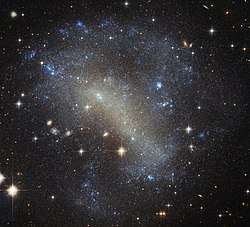IC 4710
IC 4710 is galaxy in southern constellation of Pavo, roughly 34 million light-years away.
| IC 4710 | |
|---|---|
 Hubble Space Telescope image of IC 4710 | |
| Observation data (J2000 epoch) | |
| Constellation | Pavo |
| Right ascension | 18h 28.3m[1] |
| Declination | −66° 58′[1] |
| Distance | 10.3 megaparsecs (34 Mly) |
| Apparent magnitude (V) | 11.9[1] |
| Characteristics | |
| Type | Irr[1] |
| Apparent size (V) | 3.6′ × 2.8′[1] (36,000 light-years in diameter) |
| Other designations | |
| LEDA 61922, IRAS 18235-6700,[2] PGC 61922, ESO 103-22 | |
Discovered on August 18, 1900 by astronomer DeLisle Stewart, this galaxy is composed of bright stars, with bright pockets — marking bursts of new star formation — scattered around its edges.[3] It has a diameter of 36,000 light-years.
IC 4710 is classified as dwarf irregular galaxy. As the name suggests, such galaxies are irregular and chaotic in appearance, lacking central bulges and spiral arms — they are distinctly different from spirals or ellipticals. It is thought that irregular galaxies may once have been spirals or ellipticals, but became distorted over time through external gravitational forces during interactions or mergers with other galaxies. Dwarf irregulars in particular are important to our overall understanding of galactic evolution, as they are thought to be similar to the first galaxies that formed in the Universe.[3]
IC 4710 lies in the southern constellation of Pavo (The Peacock),[3] which also contains the spiral galaxy which is mimic to Milky Way, NGC 6744.
References
- Dunlop, Storm (2005). Atlas of the Night Sky. Collins. ISBN 978-0-00-717223-8.
- "Hubble Observes Dwarf Irregular Galaxy IC 4710 | Astronomy | Sci-News.com". Breaking Science News | Sci-News.com.
- "A frenzy of stars". www.spacetelescope.org. ESA/Hubble.